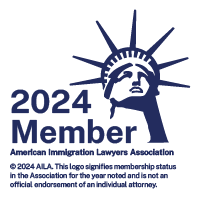Every month, the Department of State (DOS) receives information from the National Visa Center (NVC) about the total of visa applicants in the queue. From there, they predict the number of visas that would be available next month. Every year, the US makes available a total of approximately 226,000 family-based visas, 140,000 employment-based visas, and 55,000 Diversity Lottery visas, which is the topic of another blog. These total amounts are divided into preference categories and then divided into several specified countries and the rest of the world to determine how many visas are available for each country of chargeability. That number is then divided into the number of months to determine the number of visas for each preference category from each country that will be accepted each month.
Please note, the country of chargeability is the applicant's country of birth, not his/her country of citizenship. So, for example, someone who was born in China, regardless of his/her citizenship, would count against the quota provided for China. Moreover, fluctuations in the priority dates happen often for applications chargeable to countries such as China and India due to the higher volume of immigrants from those countries. This also explains the requirement for the separate visa quotas provided for these countries in the Visa Bulletin.
II. Retrogression
With the release of the June 2016 visa bulletin on May 6, 2016, retrogression has been a big concern with those waiting for their priority dates to be current or those who have filed their Adjustments of Statuses last month believing that their priority date was current. In this blog, we will be explaining the retrogression as illustrated by the June and May 2016 Visa Bulletins, using the examples of India and China.
If we look at the June 2016 bulletin and compare it with last month's bulletin, we see retrogression at several preference categories for visas chargeable to China and India. As such, we will be using China and India and the F4 category to demonstrate retrogression.
Please see the charts below for illustration:
A. Application Final Action Dates for Family-Sponsored Preference Cases
JUNE 2016
| Family-Sponsored
|
All Chargeability Areas Except Those Listed
|
CHINA-mainland born
|
INDIA
|
MEXICO
|
PHILIPPINES
|
|---|---|---|---|---|---|
| F4
|
8-Aug-03
|
1-Jan-03
|
1-Jan-01
|
15-Apr-97
|
1-Dec-92
|
| CHINA-mainland born: 1-Jan-03
INDIA: 1-Jan-01
MEXICO: 15-Apr-97
PHILIPPINES: 1-Dec-92
| |||||
MAY 2016
| Family-Sponsored
|
All Chargeability Areas Except Those Listed
|
CHINA-mainland born
|
INDIA
|
MEXICO
|
PHILIPPINES
|
|---|---|---|---|---|---|
| F4
|
22-Jul-03
|
22-Jul-03
|
22-Jul-03
|
8-Apr-97
|
1-Oct-92
|
| CHINA-mainland born: 22-Jul-03
INDIA: 22-Jul-03
MEXICO: 8-Apr-97
PHILIPPINES: 1-Oct-92
| |||||
If we compare the charts above for Family-Sponsored Fourth Preference Visas, we see that the cut-off dates for both China and India had moved from July 22, 2003 to January 1, 2003. This means that, in May, the DOS was providing visa numbers to applications with priority dates earlier than July 22, 2003. However, in June 2016, the DOS will no longer be accepting applications with priority dates of January 1, 2003 to July 22, 2003. In other words, the cut-off date has moved back 6 months.
III. Why Retrogression?
The DOS has explained that the way they determine the number of visas that they allot to each preference category every month is similar to a family determining the monthly household budget. They consider the number of visa numbers that were given out in the past, how many were used, and from there, determine what the number of future visas they will need to give out. The determination of future visas is usually an estimate.
We will continue with the F4 preference category example above as illustration. As we know from the Visa Bulletin, the DOS allows 65,000 visas from the F4 preference category for the 2016 fiscal year, this averages to around 5,500 visas per month.
In May 2016, the DOS published that they will begin accepting all applications with a priority date earlier than July 22, 2003. However, we suspect they realized later in April that there were much more applications than they had expected. In this case, they had to retrogress to January 1, 2003 to allow them time to process the applications that were already submitted..Retrogression would lessen the number of visa applications that they accept and would have to process for the month of June. .
The concept of retrogression is complex even for trained professionals. The cut-off dates listed in the Visa Bulletin each month are unpredictable and in constant fluctuation. Rest assured that Zhang-Louie, Immigration Legal Counsel is tracking these fluctuations closely every month. We would be able to prepare your Adjustment of Status applications and file them as soon as your priority date becomes current. Contact us at 978-482-7728 for any questions.






